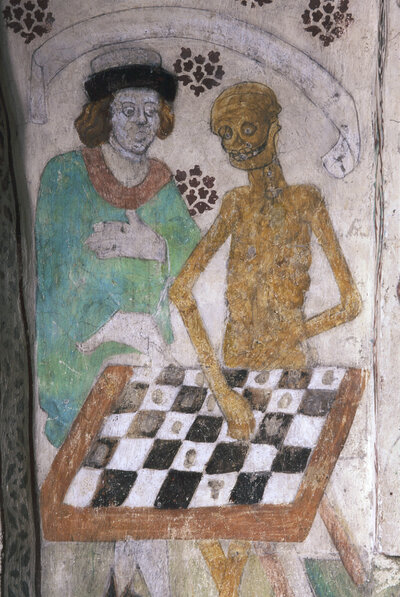1957’s ‘The Seventh Seal,’ written and directed by Swedish filmmaker, Ingmar Bergman, is a slow burning mediation on life and death.
On first watch, the film is a slow burn. But like many films, a second watch yields fruitful resonance.
Death playing chess by Albert Pictor (15th century). Image via Europeana.
The story is set in the Middle Ages, where a knight and his squire returning from the Crusades rest at a beach. The knight, played by an ever-excellent Max Von Sydow, encounters the character of Death, and challenges him to a game of chess in order to prolong his date with destiny. This game last the whole movie, as the knight, squire, and an eventual comedy troupe journey through towns and the countryside.
Upon first viewing, the images themselves can be a bit stark. And while wholly serious, if you don’t give the film a chance, the heightened reality can feel a bit silly. Roger Ebert wrote that “images like that have no place in the modern cinema, which is committed to facile psychology and realistic behavior.” Ebert viewed this film as more in common with the silent era, one that played up dramatic elements. The film requires immersion and suspension of disbelief in order to achieve its broader thesis.
Ebert continued that Bergman “was bold enough to approach his subject in a literal manner; to actually show the knight playing chess with Death, an image so perfect it has survived countless parodies.”
As I view and study the film, I find these choices intentional and effective. It is no accident that the film takes place after the Crusades. The knight, Antonius Block, has spent a decade fighting in wars of ultimate futility. He returns to even more apathy and despondence, as his fellow countrymen are dying by vast numbers from the plague.
This setting is the bleakest possible. Furthermore, it is a religious world. Block’s sacrifice in the Crusades was meant to be holy and for God, and he returns to vast despair.
The film strikes these tonal notes and holds the harsh milieu for the entire film. Yet under the looming shadow of Death, there are a few moments in the film that give hope.
“I wrote this film to conjure up my own fear of dying,” explained Bergman. Bergman was in his late 30s at the time and was apparently dealing with stomach issues. He eventually got over the fear and perhaps the film itself played as some catharsis in that regard. The film, in a literal sense, stares Death in the face. The film’s world and thus the audience, then, deals with the ramifications of the ever-looming presence of Death.
Mia and Jof. Image via BFI.
But all is not gloom. In the middle of the film, as Block enjoys strawberries and milk with others, the audience sees what human happiness can look like. It is a brief moment, however fleeting, where the characters can simply enjoy being alive and in the company of others through friendship and warmth. At the end of the scene, the camera goes to Death, who is waiting, and the music changes, but Death’s presence did not alter the reality of that joyful moment.
Jof and Mia, the light in this dark world, travel through the woods and survive a storm later in the film. After one of the famous closing shots that seal the fate of Block and other principal characters, Jof and Mia are together smiling as a family and almost literally go off into the sun. With our knowledge of modern progress in mind as we watch the film, the audience knows that human joy and hope, in the darkest of places, is what has helped us survive throughout the ages. Though the plague and war doesn’t follow all of us, the idea of Death is still there regardless of life’s circumstances. Jof, Mia, and the young child, demonstrate the tools for humanity to somehow get through.
That final glimpse of hope, joy, and life was enough of an image to have me leave the film optimistic, despite the world of Death that Bergman displayed. The film is thus ultimately a study of life and our primal fear of the end, where the only way to conquer it is to realize the beauty of the moments around us.
- JG



